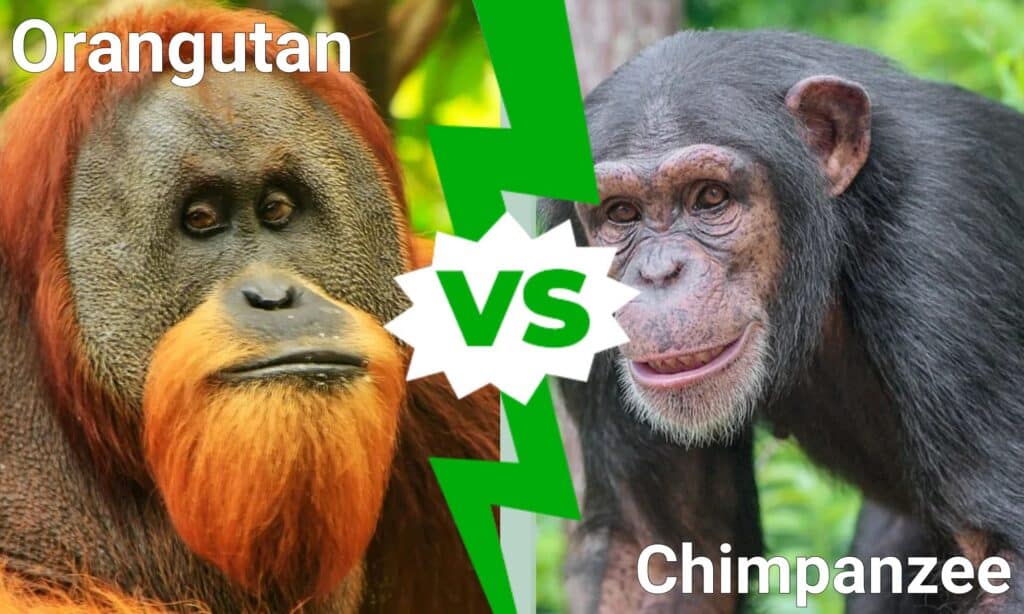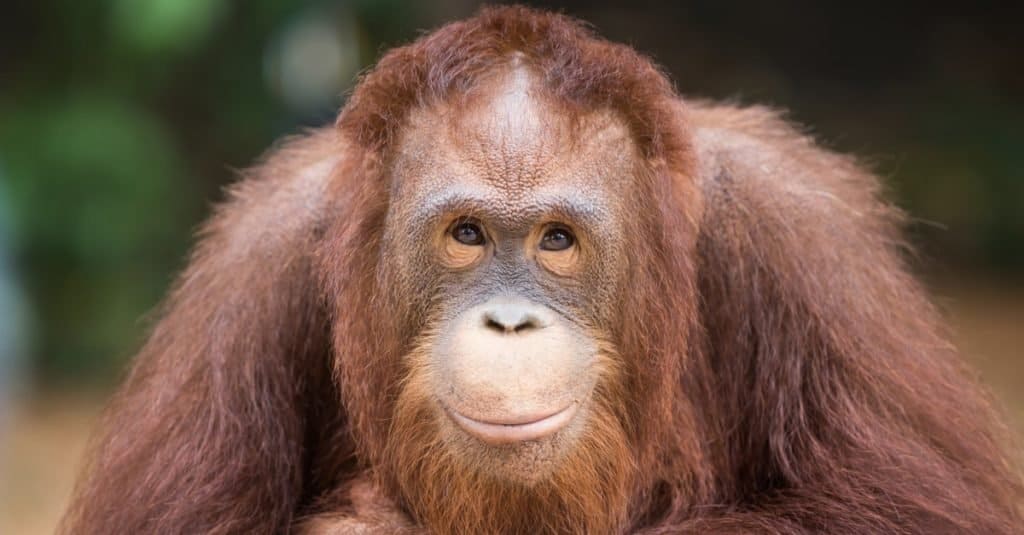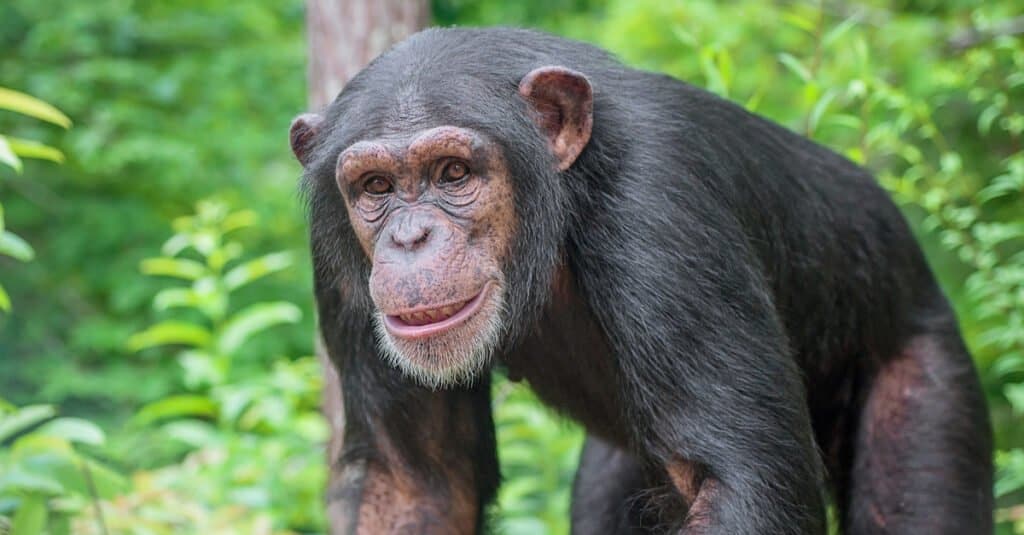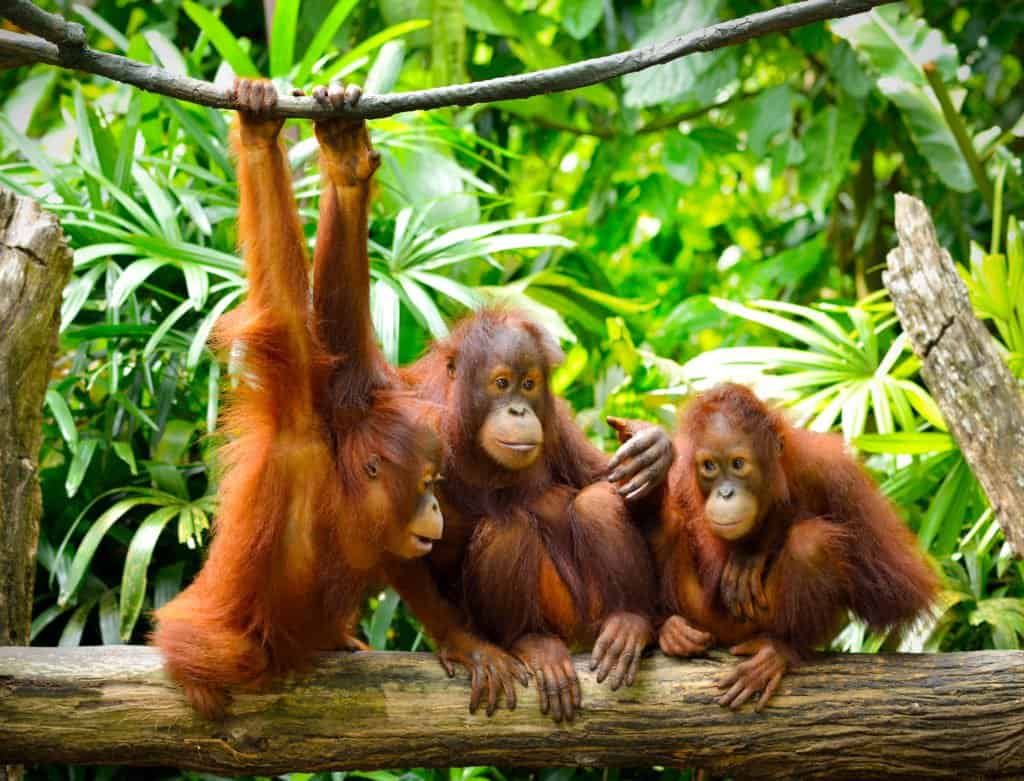Both the orangutan and chimpanzee are among the four types of great apes. They share a certain percentage sequence similarity of their DNA to humans, with the orangutan genomes being 97% identical and the chimpanzees at 99%. Both have shown remarkable abilities to think and communicate, have the ability to use tools available around them to their advantage, can be trained to learn other skills, and are, in fact, among the list of top 10 smartest animals on Earth. Both can also adapt to arboreal living and are almost alike in their diet. With all these similarities and more, what are the differences between an orangutan vs a chimpanzee? This article will talk about five essential features to answer that question.
Comparing Orangutans and Chimpanzees

| Orangutan | Chimpanzee | |
|---|---|---|
| Size | Height: 1.3 to 1.8 meters or 4.3 to 5.9 feet Weight: Males weigh around 130 kg or 285 lbs. Females weigh 37 kg or 82 lbs. or less. | Height: 1 to 1.7 meters or 3.3 to 5.6 feet Weight: Males weigh around 40-70 kg or 88-154 lbs. Females weigh 27-50 kg or 60-110 lbs. |
| Reproduction and lifespan | Breeding interval: once every 8 years; said to be slowest to reproduce Cycle: 29-32 days Gestation period: 259 days Lifespan: 50-60 years | Breeding interval: once every five or six years Cycle: up to 36 days Gestation period: 243 days Lifespan: 30-40 years |
| Social behavior | Gentle, primarily solitary | Aggressive, highly social |
| Skin and hair color | Skin: Dark tan or dark gray Hair Color: dark brown to reddish-orange | Skin: Generally white but face, hands, and feet are black. Hair color: black or brown |
| Habitat | Southeast Asian islands of Borneo and Sumatra | Central to Western Africa |
The 5 Key Differences Between Orangutans and Chimpanzees
The main differences between orangutans and chimpanzees include their size, reproduction and lifespan, social behavior, skin, and habitat. Although the two are unique in their own ways, what’s most remarkable about orangutans is their cognitive ability to understand the reason behind specific actions. In a study by biologist Robert Shumaker, it was found out that orangutans can grasp the “less is more” rule. Researchers from Scotland’s University of St. Andrews also suggest that orangutans can “talk” about their pasts. Arguably, chimpanzees may also be able to understand these but perhaps with different motivations and under different circumstances. If we put the two against each other, the bet on who the winner will be might not be easy. Below, we’ll dig deeper into each of their differences.
Orangutans vs Chimpanzees: Size

Orangutans weigh more than chimpanzees.
©Everything I Do/Shutterstock.com
Comparing the sizes of these two, orangutans are taller and weigh heavier than chimpanzees. Orangutans may grow at about 1.3 to 1.8 meters or 4 feet 3 inches to 5 feet 9 inches. Males may be about twice or thrice the size of females. On the other hand, chimpanzees stand at about 1 to 1.7 meters or 3 feet 3 inches to 5 feet 6 inches on average. Males are likewise larger than females.
There may not be that much height difference, but orangutans have more muscle mass, weighing about 37 to 130 kg or 82 to 285 pounds. Chimpanzees weigh only about 27 to 70 kilograms or 60 to 154 pounds.
Orangutans vs Chimpanzees: Reproduction and Lifespan

Chimpanzees do not live as long as orangutans.
©Crystal Alba/Shutterstock.com
Orangutans may live longer but are slower to reproduce. Female orangutans only give birth once every eight years to only one infant with a rare chance of producing twins. This is said to be the longest breeding interval of any mammal. Wild female orangutans live at an estimated 53 years, while males live at least 58 years. In captivity, some live up to 60 years on average.
Female chimpanzees, in contrast, may breed throughout the year but generally may have three children in their lifetime and give birth every five or six years. Once pregnancy ensues, their cycle resets after 2.5 to 5.5 years. Individual lifespans among chimpanzees vary, but most of them live between 30 to 40 years. Despite high infant mortality rates, some get to live over 70 years old.
Orangutans vs Chimpanzees: Social Behavior

Chimpanzees are highly social animals.
©Kletr/Shutterstock.com
Orangutans are used to solitary living, while chimpanzees are highly social. Chimpanzees live in groups of 20 to 30 individuals, which can grow up to several dozen as opposed to that of orangutans that have a peaceful solitary lifestyle. Chimpanzees also have a complex social structure and instinct to call each other when imminent danger surfaces. They are used to violent behavior and are more likely to get into physical confrontations.
Orangutans, despite their size and brute strength, are said to be gentle apes. Male chimpanzees often fight mainly for social dominance and other things that there have even been records of them attacking and killing people. In contrast, male orangutans rarely engage in fights except when it is over their mate or territory.
Orangutans vs Chimpanzees: Skin and Hair Color

It’s usually easy to spot orangutans because of their reddish-orange hair.
©tristan tan/Shutterstock.com
Orangutans are easier to spot due to their dark brown to reddish-orange hair as opposed to the brown or black hair of chimpanzees. They are commonly called red apes as their dark tan, or dark gray skin is covered with relatively coarse and usually sparse dark brown to reddish hair. Chimpanzees generally have white skin beneath their brown or black hair, but their face, hand, and feet are black. The faces of the younger ones may be whitish or pinkish.
Orangutans vs Chimpanzees: Habitat
Orangutans live in the rainforests of the Southeast Asian islands of Borneo and Sumatra, usually along waterways and in lowlands. Chimpanzees, on the other hand, are found in the grasslands and tropical moist forests of central to western Africa and savannas of equatorial Africa.
Given the difference in their habitat, the chances of orangutans and chimpanzees crossing paths and battling each other are very slim. Yet, given their strengths, weaknesses, and key features that set them apart from one another, it can be somehow figured out which ape might win during a fight.
The photo featured at the top of this post is © Darren Hopping-Mills/Shutterstock.com
Thank you for reading! Have some feedback for us? Contact the AZ Animals editorial team.






